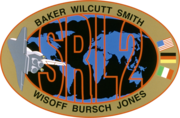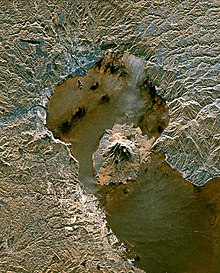STS-68
| Mission emblem | |||
|---|---|---|---|

|
|||
| Mission dates | |||
| Mission: | STS-68 | ||
| COSPAR-ID : | 1994-062A | ||
| Crew: | 6th | ||
| Begin: | September 30, 1994, 11:16:00 UTC | ||
| Starting place: | Kennedy Space Center , LC-39A | ||
| Landing: | October 11, 1994, 17:02:08 UTC | ||
| Landing place: | Edwards Air Force Base , Runway 22 | ||
| Flight duration: | 11d 5h 46m 08s | ||
| Earth orbits: | 182 | ||
| Rotation time : | 88.9 min | ||
| Orbit inclination : | 57.0 ° | ||
| Apogee : | 226 km | ||
| Perigee : | 213 km | ||
| Covered track: | 8.7 million km | ||
| Payload: | Space Radar Laboratory | ||
| Team photo | |||
 v. l. No. Front: Thomas Jones, Peter Wisoff, Steven Smith, Daniel Bursch; Back: Michael Baker, Terrence Wilcutt |
|||
| ◄ Before / After ► | |||
|
|||
STS-68 ( english S pace T ransportation S ystem) is a mission designation for the US Space Shuttle Endeavor (OV-105) of NASA . The launch took place on September 30, 1994 after a launch attempt had previously been canceled on August 18, 1994. It was the 65th space shuttle mission and the seventh space shuttle Endeavor flight.
team
- Michael Baker (3rd space flight), commander
- Terrence Wilcutt (1st spaceflight), pilot
- Thomas Jones (2nd space flight), mission specialist
- Steven Smith (1st Spaceflight), Mission Specialist
- Daniel Bursch (2nd space flight), mission specialist
- Peter Wisoff (2nd space flight), mission specialist
Mission overview

During the ten-day mission, the Space Radar Laboratory (SRL), the payload in Endeavor's hold, made its second flight. The SRL, whose first flight was during the STS-59 in April 1994, had provided scientists with very detailed information that helped distinguish human-influenced environmental changes from natural changes. SRL 2 provided radar images for systematic scientific studies in geology, geography, hydrology, oceanography, agriculture and botany.
First attempt to start on August 18, 1994
The scheduled launch on August 18, 1994 was canceled at T-1.9s just before the Solid Rocket Boosters (SRBs) should have been detonated. The three main engines of the shuttle were already ignited and deactivated again (main engine cut-off). The reason was that the temperature of the "High Pressure Oxidizer Turbopump" (HPOT) of engine three, which was supposed to pump liquid oxygen to the engine, was too high. Computers then automatically prevented the SRBs from igniting and the shuttle remained on the ground. If the start had not been aborted, it could have happened that engine no. 3 would have failed during take-off. Astronaut Thomas D. Jones writes about it on his blog.
Main components and research objectives
The SRL includes Spaceborne Imaging Radar-C / X-Band Synthetic Aperture Radar (SIR-C / x-SAR) and Satellite Pollution Measurement (MAPS). The German Space Agency DARA and the Italian Space Agency (ASI) supervised the X-SAR device. The imaging radar of the SIR-C / X-SAR instruments is able to take measurements from practically any region, at any time, regardless of weather or sunlight conditions. The radar waves can penetrate clouds and under certain conditions they can “see” through vegetation, ice and extremely dry sand. Scientists can often only explore inaccessible regions of the earth's surface with the help of radar.
The data from the SIR-C / X-SAR provided information on how much in the complex Earth system processes that control the movement of land, water, air and life forms work together to make it a habitable planet. In particular, the scientific team wanted to study the mass of vegetation cover , the extent of snow packs, wetlands, the geological properties of rock types and their distribution, volcanic activities, the height of sea waves and wind speeds . STS-68 flew over the same areas that STS-59 was observing, so the geoscientists could study seasonal changes that occurred in these areas between missions.
An international research team of 49 scientists and 3 partners led the experiments of the SIR-C / X-SAR. 13 nations were represented: Australia, Austria, Brazil, Canada, China, Great Britain, France, Germany, Italy, Japan, Mexico, Saudi Arabia and the USA. The MAPS experiment measured the global distribution of carbon monoxide in the troposphere or the layers below. Measurements of carbon monoxide, an important molecule in several chemical cycles, provide scientists with evidence of how well the atmosphere can clean itself of greenhouse gases, the chemical constituents that increase the temperature of the earth's atmosphere.
STS-68 ensured the continuation of NASA's GAS program. The project gives a researcher or an organization the opportunity to conduct their experiments in space during a shuttle mission. Two universities, North Carolina A&T State University and the University of Alabama in Huntsville and the Swedish Space Corporation "Soina" had small, self-contained payload units that flew with them during the mission. Other GAS units in the payload bay held 500,000 commemorative stamps for the U.S. Postal Service commemorating the 25th anniversary of the Apollo 11 moon landing.
Other scientific components
Other research units of the payload were the Biological Research in Canister (BRIC), which was used for the first time, and the Military Applications of Ship Tracks (MAST), a military program to study ship routes, which was flown for the first time. The BRIC experiments were funded by the NASA Office of Life and Microscopic Research Institutions, a program designed to study the effects of microscopic gravity on a wide range of physiological processes in higher plants and arthropods, such as: B. spiders, millipedes, crabs. MAST is an experiment paid for by the Office of Naval Research (ONR). It was part of a 5-year research program developed by the ONR to study the impact of ships on the marine environment.
Other research units examined the growth of proteins, cell division under space conditions and the effects of cosmic rays.
See also
Web links
- NASA Mission overview (English)
- Video summary with comments of the crew (English)
- STS-68 in the Encyclopedia Astronautica (English)
Individual evidence
- ↑ STS-68 Launch Pad abort Article on aborting the launch (English)
